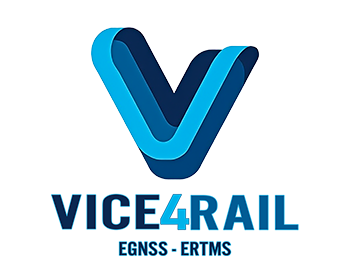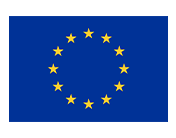Project
impact
VICE4RAIL has a straightforward impact on closing the gaps yet preventing the adoption of the GNSS for the rollout of GNSS-based ERTMS solutions in Europe, complementing the satellite tasks of the Europe Rail System Pillar and Flagship Project 2.
As the project unfolds, it promises to leave a lasting imprint on a permanent inclusion of GNSS technologies into the actual ERTMS architecture and its evolutions. First and foremost, the testing environment proposed by VICE4RAIL represents a paradigm shift in the approach to evaluating and certifying railway technologies. The integration of real and synthetic sensor data, coupled with real-time closed-loop operations, not only enhances the realism of testing scenarios to consider the GNSS characteristics but also sets the stage for a faster certification process. This, in turn, directly impacts the credibility of GNSS technologies for the safety of railway systems, assuring stakeholders that new GNSS technologies undergo rigorous and dynamic testing before deployment. By advancing the understanding and modelling of multipath effects in a railway context, the project contributes to the development of more accurate and dependable GNSS-based localization for trains. This, in turn, will impact on the higher precision in planning train separation with shorter headways meaning higher capacity for railway operations, with positive implications for both passenger and freight transport.
VICE4RAIL will contribute to the roadmap to release the new TSI for introducing the GNSS technology into the ERTMS standard. In essence, the impact of VICE4RAIL is two-fold: to close the gaps for the certification of GNSS in the ERTMS ecosystem and to ensure an early roll-out of GNSS-based ERTMS systems across Europe.
VICE4RAIL has a straightforward impact on closing the gaps yet preventing the adoption of the GNSS for the rollout of GNSS-based ERTMS solutions in Europe, complementing the satellite tasks of the Europe Rail System Pillar and Flagship Project 2.
As the project unfolds, it promises to leave a lasting imprint on a permanent inclusion of GNSS technologies into the actual ERTMS architecture and its evolutions. First and foremost, the testing environment proposed by VICE4RAIL represents a paradigm shift in the approach to evaluating and certifying railway technologies. The integration of real and synthetic sensor data, coupled with real-time closed-loop operations, not only enhances the realism of testing scenarios to consider the GNSS characteristics but also sets the stage for a faster certification process. This, in turn, directly impacts the credibility of GNSS technologies for the safety of railway systems, assuring stakeholders that new GNSS technologies undergo rigorous and dynamic testing before deployment. By advancing the understanding and modelling of multipath effects in a railway context, the project contributes to the development of more accurate and dependable GNSS-based localization for trains. This, in turn, will impact on the higher precision in planning train separation with shorter headways meaning higher capacity for railway operations, with positive implications for both passenger and freight transport.
VICE4RAIL will contribute to the roadmap to release the new TSI for introducing the GNSS technology into the ERTMS standard. In essence, the impact of VICE4RAIL is two-fold: to close the gaps for the certification of GNSS in the ERTMS ecosystem and to ensure an early roll-out of GNSS-based ERTMS systems across Europe.
SPECIFIC NEEDS
To close current gaps still preventing the adoption of GNSS for the ERTMS system there are needed:
Certification Process: compliance with CENELEC norms.
GNSS Performance assessment: to advance the understanding and modelling of GNSS and IMU performance, evaluating multipath effects and faults with very low probability of occurrence.
Exploitation of EGNOS: usability of GNSS continuity designed for aviation to meet railway RAMS (EN 50126).
Share- of best practices for standard multimodal applications: synergy for the certification process of GNSS in other transport means.
EXPECTED RESULTS
Certification Process in line with CENELEC norms: Reduced certification time and enhanced reliability in evaluating railway technologies.
A Standardizable approach to:
- Use GNSS receivers
- Use interoperable Au-Network
Improved GNSS-based localization for trains, leading to enhanced safety and precision in railway operations.
Hybrid Virtualized Test Bed
- For supporting the certification
- To validate GNSS performance
- To scale at EU-Global level
Guidance and recommendation on the use of GNSS for ERTMS
- certification of common elements
Integrity Monitoring Au-networks
IMPACTS
The expected change after successful dissemination and exploitation of project results:
- Inclusion of EGNSS into ERTMS as requested by EU Parliament directive
- Use EGNSS infrastructures for the ERTMS
- New GNSS products
- Modal shifts increase capacity to move people and goods to rail transport that is less polluting and more energy efficient than other means of transport
- Global leadership for safer and autonomous driving: export ERTMS and EGNSS know-how for autonomous cars and ships
- Lower ERTMS Costs



